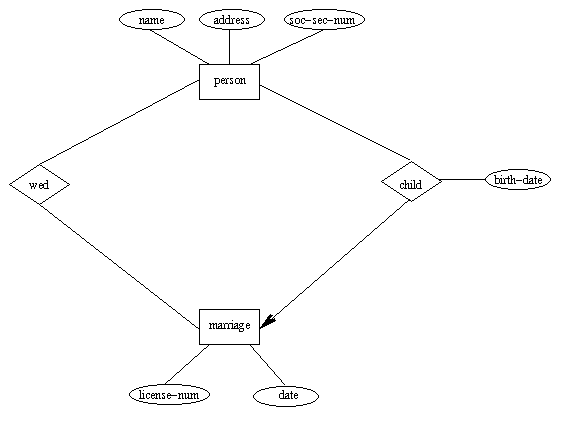
- (6 pts) Find all candidate keys for each entity set and designate a primary key for each. Document any assumptions about entities that affect the choice of candidate keys.
- (8 pts) Compute a superkey for each relationship set using the algorithm given in class. Find all candidate keys that are subsets of this superkey. Document any assumptions that affect the choice of candidate keys.
- (5 pts) Give the relation schemes of the relations that these entity and relationship sets would be reduced to.
- (8 pts) What does the arrowhead on the link between child and marriage mean? What does the presence of the arrowhead say about the relationship between children and marriages?
The database has relations bank-robbed (which stores information about banks that the gang has already robbed), bank- to-rob (which stores information about banks that the gang plans to rob), member (which stores information about gang members), and has-robbed (which stores information about which gang members have participated in robberies of what banks). Note that the gang may be planning to rob a bank that they have already robbed one or more times in the past. The schemes of these relations are:
Bank-robbed-scheme = (name: string, address:string,
number-of-depositors:integer)
Bank-to-rob-scheme = (name: string, address:string,
number-of-depositors:integer)
Member-scheme = (name:string, address:string, years-in-prison:integer,
banks-at:string, skill1:skilltype, skill2:skilltype)
Has-robbed-scheme = (member-name:string, bank-name:string,
date:string, amount:real)
where attribute banks-at of member is the name of the bank where the gang member does his or her banking, and skilltype is an enumerated type consisting of {lock-picking, shooting, driving, counting-money, public-relations}.
- Give relational algebra and SQL expressions for the following
queries:
- (5 pts) Find the names and addresses of all gang members who have spent more than 10 years in prison.
- (7 pts) Find the names and addresses of all banks that the gang has never robbed, but plans to rob someday.
- (7 pts) Find all skills of all members of the gang. The resulting relation should have only one attribute (column).
- (9 pts) Find the name and address of each bank robber who has robbed his or her own bank (i.e. the bank he or she banks at).
- (5 pts) If {name} is a candidate key for member and we have
tuple variables t and s such that
t
 member and s
member and s
 member and t[name] = s[name], what must the
relationship between tuple t and tuple s be?
member and t[name] = s[name], what must the
relationship between tuple t and tuple s be?
- (8 pts) Comment on the design of this relational database. (Is the gang leader a competent database designer?) In your answer, consider design issues such as the potential for duplication of information, how well the design permits storage of information that appears to be of interest, if null values would be required very often, and any other relevant design issues. (I'll give extra credit for especially good answers.)
create table
command part of SQL's DDL, DML, both, or neither? Customer-scheme = (name, address, cust-num)
Flyrod-scheme = (manufacture, length, line-weight, flyrod-stock-num)
Purchased-scheme = (cust-num, flyrod-stock-num, date)
- (3 pts) Express the following SQL query in relational algebra:
select manufacturer, line-weight, date from customer, purchased, flyrod where customer.cust-num = purchased.cust-num and purchased.flyrod-stock-num = flyrod.flyrod-stock-num and name = "Elvis Presley" - (6 pts) Write a relational algebra query that produces a relation
containing just the
cust-nums of every customer who has purchased at least one flyrod made by each of the manufacturers represented in theflyrodrelation. (Hint: first write a query that returns a relation associating a customer'scust-numwith all of the manufacturers of flyrods that the customer has purchased.) - Give the SQL command (or sequence of commands) needed to:
- (6 pts) Create the
flyrodrelation. Use any reasonable domains for the attributes. Your answer should specify thatflyrod-stock-numis the primary key for relations onFlyrod-scheme, and should also specify the domain constraint that is always associated with any primary key in SQL. - (4 pts) Delete all flyrod models that no one has purchased from the
flyrodrelation.
- (6 pts) Create the
Part-scheme = (part-num, description, groovyness, quantity) Supplier-scheme = (supplier-name, address, phone-number) Supplies-scheme = (part-num, supplier-name, address, cost)The primary key for relations on
Part-scheme is part-num, and
the primary key for relations on Supplier-scheme is
{supplier-name, address}.
- The management of the lava lamp company wants to study the relationship
between the
groovynessand thecostof parts.- (5 pts) Use SQL to define a view that associates the
groovynessof each part with itscost. Note that the same part can cause multiple tuples to be part of this view if that part has multiple suppliers. - (5 pts) Should database modifications be allowed through this view?
Why or why not?
- (5 pts) Assume that
groovynessis expressed as an integer between 1 and 10. Use SQL to write a query that returns the averagecostof a part at each level ofgroovyness, and thegroovynessassociated with thatcost. (Hint: the view you defined should be useful for doing this.)
- (5 pts) Use SQL to define a view that associates the
- Now assume that the management of the lava lamp company decides that each supplier can supply at most one kind of part - i.e. that the company will buy at most one kind of part from each supplier, even if that supplier has other kinds of parts. Thus, the company will not have two different kinds of parts in stock that were supplied by the same supplier, and will not even store the information that a supplier has other kinds of parts and could potentially supply these parts.
- (5 pts) Under this assumption, if we view
suppliesas a relationship set fromsuppliertopart(E-R model), what is the mapping cardinality of this relationship set? - (5 pts) Given your mapping cardinality from the previous part, what
should the primary key of relations on
Supplies-schemebe?